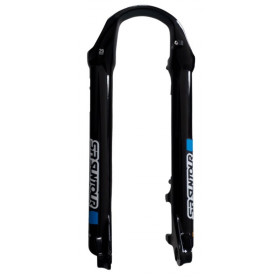-
 New productFork sliders SR Suntour XCR 29 boost
New productFork sliders SR Suntour XCR 29 boost- €44.99
Showing 1-1 of 1 item(s)
The MTB enduro fork plays a crucial role in the performance, control and riding comfort of the bike on technical and demanding terrain. Here is a description of its function, its characteristics and the associated standards, associated for MTB enduro :
Function of a MTB enduro fork :
1. Shock absorption:
The main function of an enduro mountain bike fork is to absorb shock and vibration from the terrain, providing ride comfort and better grip on technical, rocky and uneven trails.
2. Stability and control:
An enduro mountain bike fork contributes to the stability and control of the bike by keeping the wheels in contact with the ground and reducing excessive bounce during high-speed descents and technical sections.
3. Suspension adjustment:
Many enduro mountain bike forks feature adjustable suspension systems, allowing the rider to adjust suspension preload, compression, and rebound to suit their riding preferences and terrain conditions.
Features of a MTB enduro fork :
1. Travel:
The travel of an enduro mountain bike fork generally varies between 150 mm and 180 mm, or even more, depending on the practice and the level of commitment of the cyclist. Greater travel provides better shock absorption on technical descents and jumps, but may slightly compromise pedaling efficiency uphill.
2. Construction material:
Enduro mountain bike forks are generally made of aluminum or carbon to combine lightness, robustness and performance. Higher-end models may use advanced composite materials to reduce weight while maintaining rigidity and durability.
3. Suspension type:
Enduro mountain bike forks can be equipped with different suspension types, including coil spring suspension, air suspension, and hydraulic suspension. Each suspension type offers different performance and tuning characteristics.
4. Tube diameter:
Enduro mountain bike forks come in different fork tube sizes, usually expressed in millimeters. Common tube diameters are 32mm, 34mm and 36mm, with wider tubes providing better rigidity and resistance to twisting in the most extreme riding conditions.
Standards of a MTB enduro fork:
1. Thru-axle:
Most enduro mountain bike forks use a thru axle to securely attach the wheel to the fork. Common thru-axle diameters are 15mm front and 12mm rear, although different diameters may be used depending on the fork model and bike frame.
2. Head tube:
Enduro mountain bike forks typically use tapered headtubes for increased rigidity and better stress distribution. Common head tube standards are 1 1/8 inches at the top and 1.5 inches at the bottom.
In summary, the fork of an enduro mountain bike plays an essential role in the performance, control and riding comfort of the bike on technical and demanding terrain. With different features and standards available, it's important to choose a fork suited to your specific riding needs and level of trail engagement.
